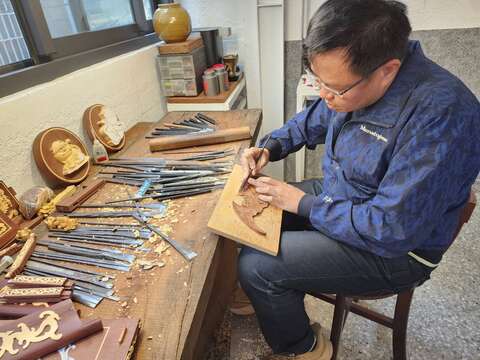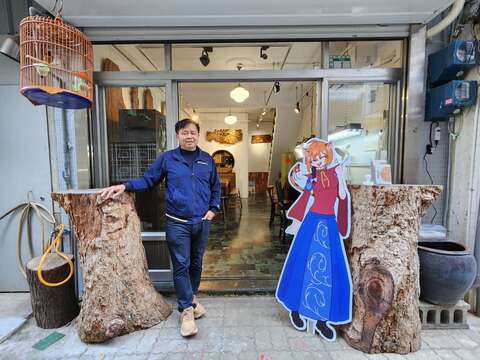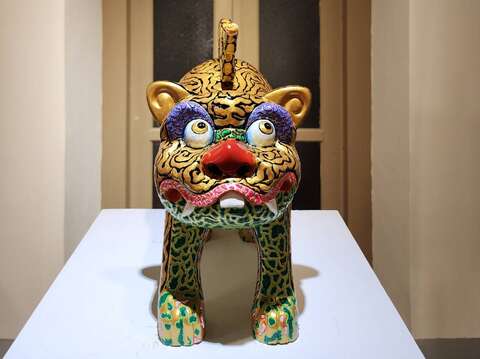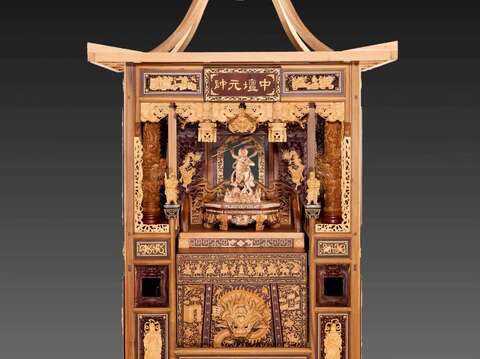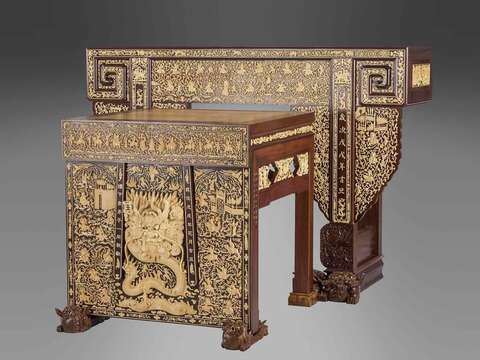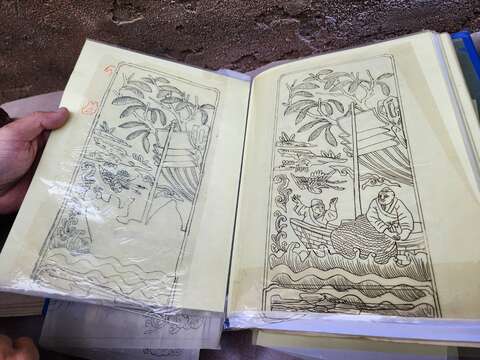“League of Extraordinary Tainan People” Series Show How Liu Jin-Wen Revolutionized Traditional Crafts through “Red Cedar Inlays in Persimmon”
Posted Date:2025-03-07
298
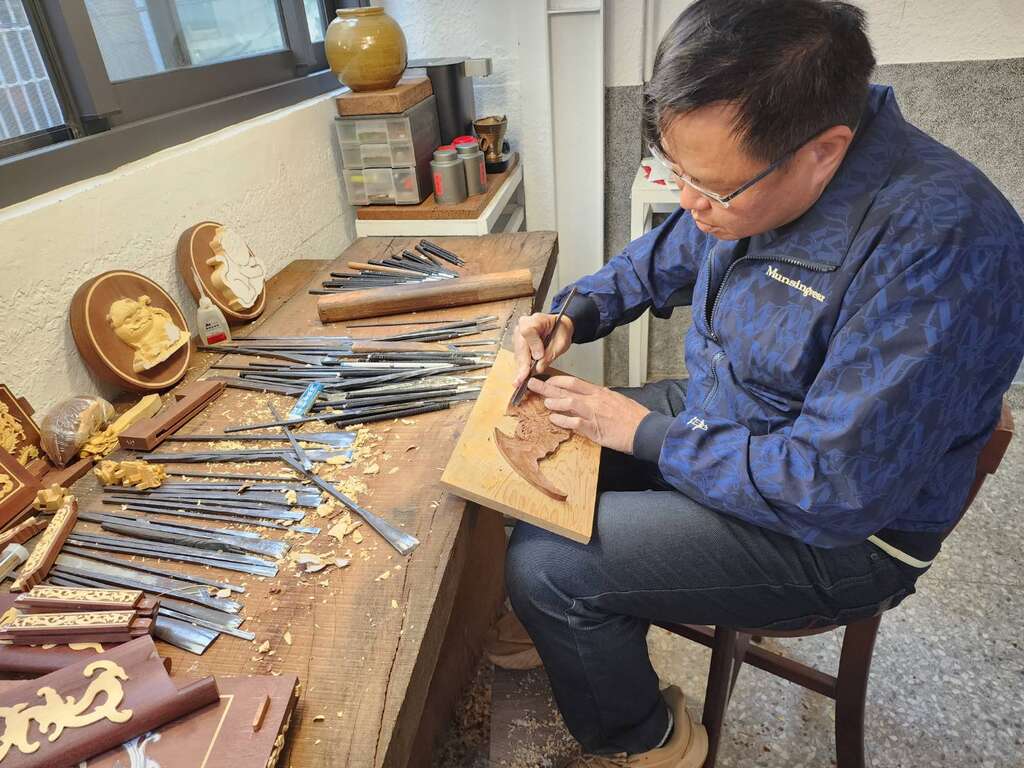
Introduce
Tainan has a rich cultural heritage and many talented people. To provide a more in-depth look at the diverse facets of Tainan, Tourism Bureau developed the “League Extraordinary Tainan People” series of articles to communicate the spirit and mindset of Tainan’s people through the life stories of master craftsmen. The articles offer the public a glimpse into the beauty of Tainan’s living culture, and provide a different kind of original itinerary in the form of corners and niches these people feel are worth exploring.
Tainan City Mayor Huang Wei-che explained that Tainan is famed as the “City of the Gods” and is home to the most number of temples in Taiwan. The unique “Red Cedar Inlays in Persimmon” carving technique is used extensively in architecture and furniture. Light-colored wooden carved inlays are set into a dark-colored timber base board to create a very strong contrast with ornate decorations. This is a traditional craft that Fucheng is famous for. As Tainan was the first city in Taiwan, this technique is also known as the “Tainan Form.” The “League of Extraordinary Tainan People” series started off with master wood carver Liu Jin-wen who has worked tirelessly to promote the “Red Cedar Inlay in Persimmon” technique and share his journey to master this craft.
Director-General Lin Kuo-hua from the Tourism Bureau of Tainan City said that despite Liu’s perennial jeans and T-shirt, behind his youthful appearance is nearly 40 years of wood carving experience. Liu grew up around Zhongxiao Street and spent most of his life around Mazulou Tianhou Temple. He had little love for books and the temple square was his classroom. The traditional virtues and classical aesthetics gradually became a part of his soul due to spending so much time in the halls of religious art. From this emerged his love for the traditional crafts. he immediately became a wood carving apprentice after finishing middle school to learn a craft. In 1997, he struck out on his own. In the beginning, he had little business and had to work part-time at appliance stores moving air-conditioners. This did not faze him however. Liu said that a person’s personality decided their fate. He believed in working hard to achieve what he believed in. He also emphasized that character was more important than portfolio. Being smart or clever is no substitute for integrity. There is nothing more important than honesty even it means being cheated.
The General Tiger statue is a common feature of temples in Tainan. In addition to being serving as the mount and vanguard of deities, it is also a symbol of wealth and good fortune so is popular with ordinary people. That’s why Master Liu attempted to combine “Red Cedar Inlay in Persimmon” with painted acrylic to create a different kind of General Tiger and this became a viral sensation. Since 2010, Liu has made a large General Tiger statue whenever it was the Year of the Tiger. The statue features the strong, solid lines of the traditional style as well as bright colors symbolizing the five elements. Liu’s distinctive color and styling have made the statues much sought after among celebrities and entrepreneurs.
Rather than clinging onto tradition, Liu not only makes innovative use of creative media but also modern technology and tools. Traditionally, the drilling part of “Red Cedar Inlay in Persimmon” required little skill and was left to apprentices. Apprentices are hard to find now so he used a CNC machine center to perform this step instead. All the other steps are carved by hand to preserve the human touch. Liu is not afraid of imitators either. He loves to share so he often holds classes, road shows and seminars. How else will people learn about “Red Cedar Inlay in Persimmon” after all? Liu Jin-wen feels that the carving community in Tainan is facing a generational gap due to the lack of new blood. Changes in the labor employment meant that the traditional apprenticeship system has fallen out of favor. While people attend seminars and classes, this is usually just out of interest and can only serve as a form of marketing. Liu fears that in the not-so-distant feature, there will be no craftsmen left in Taiwan to satisfy demand from the market and people will have to turn to China instead. These fears as well as a sense of mission drove him to research the origins and restore examples of “Red Cedar Inlay in Persimmon.” He has already collected more than 6000 sheets of transparent glutinous rice paper used for creating or tracing traditional patterns just to preserve them for future generations. Liu said that the restoration of wooden carvings is like solving a puzzle. The layout, the stories, and techniques can’t just be imagined at random. Instead, they must be carefully pieced together from the surviving design. His database of patterns serves as his secret weapon for the interpretation and re-creation of classic designs.
Being born and bred in Tainan meant that Liu Jin-wen personally witnessed the changes during the fusion of the old and new. He is particularly fond of how the founders of Tainan’s culinary culture took a genuine interest in the wellbeing of their regular customers. Including soup when ordering a bowl of dry noodles is an example of traditional hospitality. That is also why connections between people are important to Liu and he spares no effort when it comes to charitable causes. Master Liu hopes that the warmth in his artworks will help people understand traditional crafts and spur the continued development of “Red Cedar Inlay in Persimmon” both as a tradition and through innovation. Liu Jin-wen extends his sincere invitation to everyone to come and visit Tainan. Go inside the temples or stop by Liu’s wood carving workshop to admire the craftsmanship and see what everyone is raving about. According to the Tourism Bureau, the “League of Extraordinary Tainan People” series of reports will be syndicated from March 7 onwards. The reports will feature the life stories of Tainan master craftsmen and also invite the public to experience the unique style of Tainan. For more information on the latest tourist attractions and events in Tainan, please continue to follow the “Travel Tainan” website and the “Travel Tainan Facebook Fan Page.”
Tainan City Mayor Huang Wei-che explained that Tainan is famed as the “City of the Gods” and is home to the most number of temples in Taiwan. The unique “Red Cedar Inlays in Persimmon” carving technique is used extensively in architecture and furniture. Light-colored wooden carved inlays are set into a dark-colored timber base board to create a very strong contrast with ornate decorations. This is a traditional craft that Fucheng is famous for. As Tainan was the first city in Taiwan, this technique is also known as the “Tainan Form.” The “League of Extraordinary Tainan People” series started off with master wood carver Liu Jin-wen who has worked tirelessly to promote the “Red Cedar Inlay in Persimmon” technique and share his journey to master this craft.
Director-General Lin Kuo-hua from the Tourism Bureau of Tainan City said that despite Liu’s perennial jeans and T-shirt, behind his youthful appearance is nearly 40 years of wood carving experience. Liu grew up around Zhongxiao Street and spent most of his life around Mazulou Tianhou Temple. He had little love for books and the temple square was his classroom. The traditional virtues and classical aesthetics gradually became a part of his soul due to spending so much time in the halls of religious art. From this emerged his love for the traditional crafts. he immediately became a wood carving apprentice after finishing middle school to learn a craft. In 1997, he struck out on his own. In the beginning, he had little business and had to work part-time at appliance stores moving air-conditioners. This did not faze him however. Liu said that a person’s personality decided their fate. He believed in working hard to achieve what he believed in. He also emphasized that character was more important than portfolio. Being smart or clever is no substitute for integrity. There is nothing more important than honesty even it means being cheated.
The General Tiger statue is a common feature of temples in Tainan. In addition to being serving as the mount and vanguard of deities, it is also a symbol of wealth and good fortune so is popular with ordinary people. That’s why Master Liu attempted to combine “Red Cedar Inlay in Persimmon” with painted acrylic to create a different kind of General Tiger and this became a viral sensation. Since 2010, Liu has made a large General Tiger statue whenever it was the Year of the Tiger. The statue features the strong, solid lines of the traditional style as well as bright colors symbolizing the five elements. Liu’s distinctive color and styling have made the statues much sought after among celebrities and entrepreneurs.
Rather than clinging onto tradition, Liu not only makes innovative use of creative media but also modern technology and tools. Traditionally, the drilling part of “Red Cedar Inlay in Persimmon” required little skill and was left to apprentices. Apprentices are hard to find now so he used a CNC machine center to perform this step instead. All the other steps are carved by hand to preserve the human touch. Liu is not afraid of imitators either. He loves to share so he often holds classes, road shows and seminars. How else will people learn about “Red Cedar Inlay in Persimmon” after all? Liu Jin-wen feels that the carving community in Tainan is facing a generational gap due to the lack of new blood. Changes in the labor employment meant that the traditional apprenticeship system has fallen out of favor. While people attend seminars and classes, this is usually just out of interest and can only serve as a form of marketing. Liu fears that in the not-so-distant feature, there will be no craftsmen left in Taiwan to satisfy demand from the market and people will have to turn to China instead. These fears as well as a sense of mission drove him to research the origins and restore examples of “Red Cedar Inlay in Persimmon.” He has already collected more than 6000 sheets of transparent glutinous rice paper used for creating or tracing traditional patterns just to preserve them for future generations. Liu said that the restoration of wooden carvings is like solving a puzzle. The layout, the stories, and techniques can’t just be imagined at random. Instead, they must be carefully pieced together from the surviving design. His database of patterns serves as his secret weapon for the interpretation and re-creation of classic designs.
Being born and bred in Tainan meant that Liu Jin-wen personally witnessed the changes during the fusion of the old and new. He is particularly fond of how the founders of Tainan’s culinary culture took a genuine interest in the wellbeing of their regular customers. Including soup when ordering a bowl of dry noodles is an example of traditional hospitality. That is also why connections between people are important to Liu and he spares no effort when it comes to charitable causes. Master Liu hopes that the warmth in his artworks will help people understand traditional crafts and spur the continued development of “Red Cedar Inlay in Persimmon” both as a tradition and through innovation. Liu Jin-wen extends his sincere invitation to everyone to come and visit Tainan. Go inside the temples or stop by Liu’s wood carving workshop to admire the craftsmanship and see what everyone is raving about. According to the Tourism Bureau, the “League of Extraordinary Tainan People” series of reports will be syndicated from March 7 onwards. The reports will feature the life stories of Tainan master craftsmen and also invite the public to experience the unique style of Tainan. For more information on the latest tourist attractions and events in Tainan, please continue to follow the “Travel Tainan” website and the “Travel Tainan Facebook Fan Page.”
